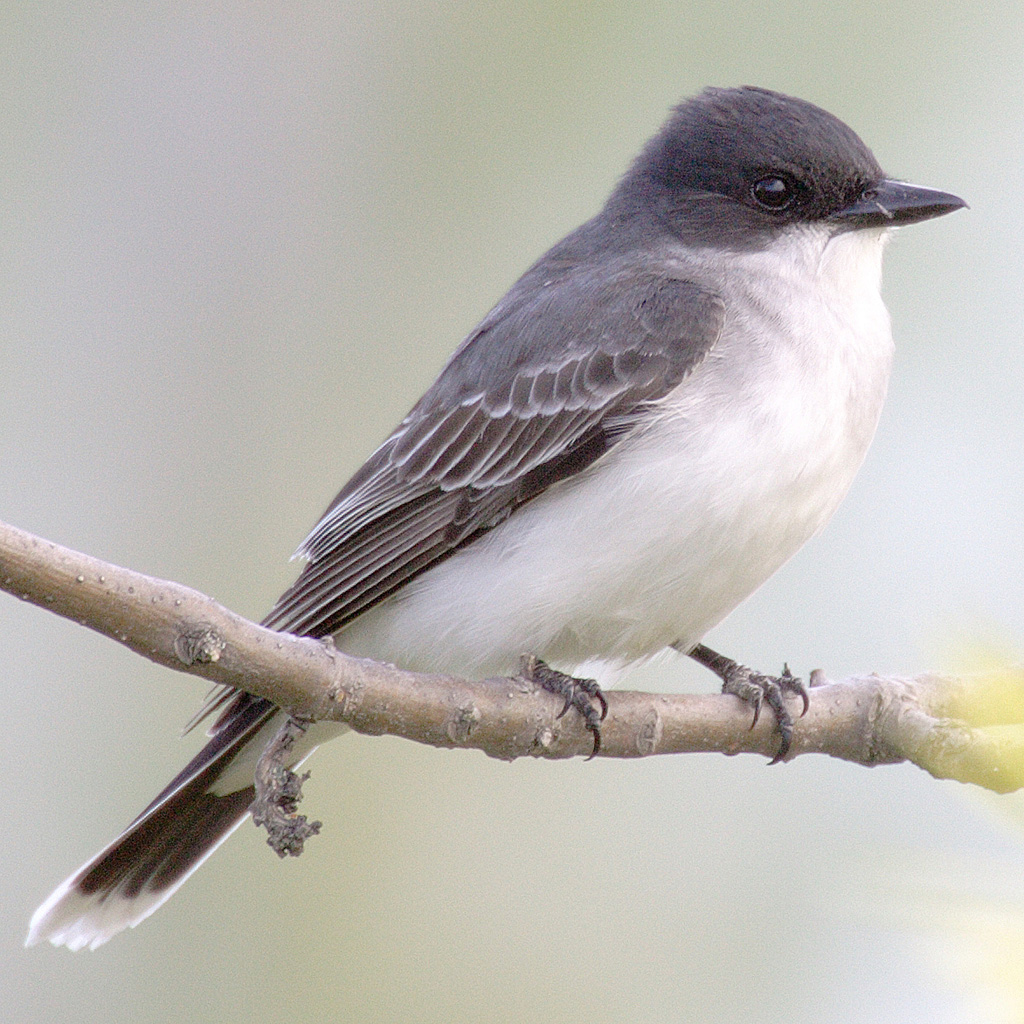Mockingbirds can be found all over North America, and they’re easily recognizable by their black and white plumage. But did you know that there are a dozen other birds that look a lot like mockingbirds?
In this blog post, we’ll take a look at some of these birds, and we’ll also discuss some of the differences between mockingbirds and their lookalikes. Who knows, you might even be able to spot a few in your backyard!
1. Gray Kingbird
Scientific name: Tyrannus dominicensis
Length: 23 centimeters (9.1 inches)
Weight: 37-52 grams
Lifespan: about 6 years
Also called Petchary and Pitirre, the Gray Kingbirds are a tyrant flycatcher species found within the range of Southeast regions of North America and the Northern coasts of South America. These birds prefer to inhabit tall trees and are abundantly found in Florida within the United States.
Both sexes of adult Gray Kingbirds appear identical in size and plumage, displaying no dimorphism. They have a grey head, dark eyes, dark, heavy bills, and a dark mask running across their eyes.
As indicated in their name, most of their upper body is grey-colored, with pure white underparts except for grey touches around their chest. Their wings and tail are washed with a brownish tinge.
Their resemblance to Northern Mockingbirds:
Both Gray Kingbirds and Northern Mockingbirds have grey upper bodies, white underparts, dark eyes, legs, and bills. They’re also roughly the same size and weight, which is why it’s easy to confuse one for the other.
Here’s how you can differentiate between the two:
- The bills of mockingbirds are considerably shorter and lighter than that of the Kingbirds.
- They have yellow irises, unlike the completely black eyes of Kingbirds.
- Their wings and tails are darker than the latter.
2. Townsend’s Solitaire

Scientific name: Myadestes townsendi
Length: 20-24 centimeters (8-9 inches)
Weight: 34 grams
Wingspan: 37 centimeters (14.5 inches)
Lifespan: around 2-4 years
Named in the memory of the American naturalist, John Kirk Townsend, Townsend’s Solitaires are a thrush species endemic to the Americas. They prefer to inhabit the Montane forests within their range but might move to lower areas during harsh winters.
These thrushes have uniformly grey plumage, short, dark bills, eyes, and legs. Their wings and tails have buff stripes, while the eyes possess bold white eye rings. Both sexes of this species have the same appearance.
Their resemblance to Northern Mockingbirds:
While both Townsend’s Solitaires and Northern Mockingbirds are similar in size and have grey heads and upper parts, that’s where their similarities end.
The mockingbirds have white underparts, unlike the grey undersides of these solitaires. They have yellow irises, whereas the latter possess fully black eyes with white eye rings.
3. Northern Shrike
Scientific name: Lanius borealis
Length: 23-24 centimeters (9 inches)
Weight: 57-79 grams
Wingspan: 30-35 centimeters (11-13 inches)
Lifespan: around 3-5 years
Initially considered a subspecies of the Great Grey Shrikes, the Northern Shrikes are large passerine birds found in North America and Siberia. These birds have six recognized subspecies, four of which are Eurasian, and the remaining belong to North America.
Northern Shrikes have a grey head, back, wings, and tail, while their underbody is white. Their hooked bills, eyes, and legs are all dark, with a prominent dark eye mask, wing bars, and tail bands. The adults are sexually monomorphic, displaying no difference in their appearance or size.
Their resemblance to Northern Mockingbirds:
The grey upper body, white underparts, and dark bills of Northern Shrikes give them a Mockingbird-like impression. The two have roughly the same length as well.
Here are some differences that set the two apart:
- The black eyes of Northern Shrikes lack the yellow irises that the mockingbirds possess.
- These Shrikes are considerably heavier than the latter.
- Their thick bills have a prominent hook which the mockingbirds lack.
- Their dark wing bars and tail bands are absent in the latter.
4. Grey Trembler
Scientific name: Cinclocerthia gutturalis
Length: 23-26 centimeters (9-10 inches)
Weight: 65-76 grams
Earlier considered conspecific with the Brown Tremblers, the Grey Tremblers are also endemic to the islands of Lesser Antilles. However, unlike the wide range of the former, these birds are only found on two islands: Saint Lucia and Martinique.
Grey Tremblers have warm grey plumage with buffy white underparts. Both their wings and faces have darker touches of olive, with brown flanks. Their dark eyes have bright orange irises. The bills of these mimids are their most recognizable features and are also used to distinguish between the sexes, with the females possessing longer bills.
Their resemblance to Northern Mockingbirds:
While the grey plumage of Grey Tremblers might make someone mistake them for Northern Mockingbirds, the two have no other similarities. Grey Tremblers’ bills are much longer than the latter and have a significant down curve.
5. Canada Jay
Scientific name: Perisorius canadensis
Length: 25-33 centimeters (9-13 inches)
Weight: 65-70 grams
Wingspan: 45 centimeters (14 inches)
Lifespan: around 8 years
Belonging to the corvid family, the Canada Jays are large songbirds popular by various nicknames like Camp Robber, Whisky Jack, and Grey Jay. These birds prefer to inhabit the coniferous forests of North America.
While Canada Jays are fairly large for a songbird, in comparison to other jays, they’re relatively smaller. They have a pale grey head with darker back, wings, and tails, while their underbody is uniformly grey as well. Their eyes, bills, and legs are all black.
Both sexes of these birds sport an identical plumage, showing dimorphism only in size, with the males being the larger ones.
Their resemblance to Northern Mockingbirds:
Canada Jays appear similar to Northern Mockingbirds due to their primarily grey plumages, dark bills, eyes, legs, and same size. However, that’s all the similarities these birds share.
Canada Jays have white faces and necks, while only the underbodies of the mockingbirds are white. Their black eyes also lack the yellow irises that the mockingbirds possess.
6. Gray Catbird
Scientific name: Dumetella carolinensis
Length: 20-24 centimeters (8-9 inches)
Weight: 35-40 grams
Wingspan: 22-30 centimeters (8-11 inches)
Lifespan: around 2-3 years
Also called Slate-colored Mockingbirds in some areas, the Gray Catbirds are a medium-sized mimid species found in North and Central America.
These birds get their name from their overall lead-grey plumage, except for their heads and undertails, which are black. Their eyes, legs, and bills are blackish as well. Both sexes of adults appear identical and can only be differentiated by their breeding behavior.
Their resemblance to Northern Mockingbirds:
While Gray Catbirds have a darker shade of grey in their plumage than the mockingbirds, when seen from afar, it’s common to confuse the two. The fact that they’re both roughly the same size doesn’t help either.
If you want to distinguish between these birds, look at their undersides. Unlike the white undersides of the Mockingbirds, Gray Catbirds’ undersides are uniformly grey. They also have black irises, while that of the mockingbirds are yellow.
7. Gray Flycatcher
Scientific name: Empidonax wrigthii
Length: 15 centimeters (5 inches)
Weight: 12 grams
Wingspan: 22 centimeters (8 inches)
Abundantly found in the arid western regions of North America, the Gray Flycatchers are tiny insectivorous birds identified by their downward-wagging tail. While these birds are small by normal standards, they’re among the larger members of their genus.
While both sexes of these birds appear identical, the male’s ability to sing can distinguish the two. Both sexes have grey heads, backs, and upper bodies, with darker touches on their wings and tails. Their eyes and legs are also dark, except for the striking white eye rings that make them stand out.
Their resemblance to Northern Mockingbirds:
Gray Flycatchers share their grey upperparts, white underbodies, dark legs, bills, and eyes with the mockingbirds. However, they’re substantially smaller in size than the latter and also weigh lesser.
Lastly, their eyes are completely black with white eye-rings, unlike the mockingbirds that have black eyes with yellow irises.
8. Warbling Vireo
Scientific name: Vireo gilvus
Length: 12-13 centimeters (4-5 inches)
Weight: 10-16 grams
Wingspan: 22 centimeters (8 inches)
Lifespan: around 11-13 years
Named after the cheerful warbling songs of the males, the Warbling Vireos are a migratory songbird species found in the deciduous forests of North America.
These tiny vireos have an olive-grey head and upperbody, with white underparts. Their eyes are brown, while their feet and legs are bluish-grey. There is no visible dimorphism between the adult sexes, both possessing identical size and plumage.
Their resemblance to Northern Mockingbirds:
While the plumage of Warbling Vireos is a combination of white and grey, just like the mockingbirds, both birds differ considerably in size. The bigger mockingbirds also have Yellow irises, whereas the vireos have dark brown eyes.
9. Blue-grey Gnatcatcher

Scientific name: Polioptila caerulea
Length: 10-13 centimeters (3-5 inches)
Weight: 5-7 grams
Lifespan: around 4 years
The Blue-grey Gnatcatchers are tiny insectivore birds found in the deciduous forests and shrublands of North America. These migratory birds breed in the Eastern parts of North America and travel south to Mexico, Cuba, Honduras, Belize, and the Bahamas.
As their name suggests, these gnatcatchers have a bluish-grey plumage, white undersides, dark bills, eyes, and legs. Their tail is darker in color and has a white band. Both sexes appear similar in appearance, displaying little-to-no dimorphism.
Their resemblance to Northern Mockingbirds:
While both Blue-grey Gnatcatchers and Northern Mockingbirds share grey-and-white coloration, the two are significantly different in their size, with the Mockingbirds being the larger species. Blue-grey Gnatcatchers also have black irises, unlike the yellow irises of the latter, and possess white eye rings.
10. Eastern Kingbird

Scientific name: Tyrannus tyrannus
Length: 19-23 centimeters (7-9 inches)
Weight: 33-55 grams
Wingspan: 33-38 centimeters (13-15 inches)
Lifespan: around 10-11 years
Belonging to the tyrant flycatcher family, the Eastern Kingbirds are a migratory kingbird species that breed in North America and migrate to South America during winters.
These large songbirds have a greyish-black head and upper body, white underparts, and a long, black tail. They also possess a tiny red crown patch which is rarely seen. Their bills, eyes, and legs are all dark in color. Both sexes of adults appear identical and are sexually monomorphic.
Their resemblance to Northern Mockingbirds:
Both Eastern Kingbirds and Mockingbirds possess grey upperparts, white under parts, dark eyes, bills, and legs. They’re roughly the same in size and body mass as well.
Here are two ways in which you can differentiate between them:
- The head and upper body of the kingbirds are slightly darker than that of the mockingbirds.
- While kingbirds have fully black eyes, mockingbirds possess yellow irises.
11. Loggerhead Shrike
Scientific name: Lanius ludovicianus
Length: 20-23 centimeters (7-9 inches)
Weight: 34-51 grams
Wingspan: 27-32 centimeters (11-12 inches)
Lifespan: around 7-8 years
Named after their disproportionately large heads, the Loggerhead Shrikes are a near-threatened shrike species found in the grasslands and open pastures of North America. They’re the only members of the Shrike family found exclusively in North America and not on any other continent.
In appearance, Loggerhead Shrikes closely resemble the Northern Shrikes. Only they are slightly smaller in size, possess shorter bills, a darker plumage, and a more prominent eye mask. Much like the latter, the adults are sexually monomorphic.
Their resemblance to Northern Mockingbirds:
While the plumage coloration of Loggerhead Shrikes matches that of the Northern Mockingbirds, the two can easily be told apart due to the differences in their appearances.
Here are some of them:
- Loggerhead Shrikes not only possess larger heads than the Mockingbirds but also have a black eye mask that the latter lack.
- Their wings and tails have bold black bands, while the darker parts of the Mockingbirds’ plumage are not that prominent.
- Unlike the short, straight bills of Mockingbirds, the Loggerhead Shrikes possess longer bills with a prominent hook.
12. Lucy’s Warbler
Scientific name: Leiothlypis luciae
Length: 9-12 centimeters (3-4 inches)
Weight: 5-7 grams
Lifespan: around 5 years
The smallest members of the New World Warbler family, Lucy’s Warblers have been named after the daughter (Lucy Hunter Baird) of the recognized ornithologist, Spencer Fullerton Baird.
These tiny birds also happen to be the palest among the wood-warblers, having a pale grey head and upper parts, white underbody, dark eyes, bills, and legs. They also have white eye-rings that are quite striking. There is no dimorphism between the appearance of the adult sexes.
Their resemblance to Northern Mockingbirds:
Despite the fact that both Lucy’s Warblers and Northern Mockingbirds have similar-colored plumage, telling them apart is easy due to the significant difference in their sizes. Mockingbirds are the larger ones and also possess yellow irises, which are absent in the warblers.
Wrapping it up
With this, we’ve come to the end of our article. We started out talking about mockingbirds and the traits that make them stand out. Then, we moved on to learn about 12 birds that share some of the other physical traits with the mockingbirds and could easily be mistaken for them.
If you’ve been paying attention so far, you’d have figured out that no matter how many similarities any of these birds might share with the mockingbirds, there are always ways to differentiate between them.
Thanks for reading! We hope you found this post helpful. If you have any questions or would like to share your suggestions with us, feel free to write us an email.
Mockingbird Symbolism and Meaning (Totem, Spirit, and Omens)










